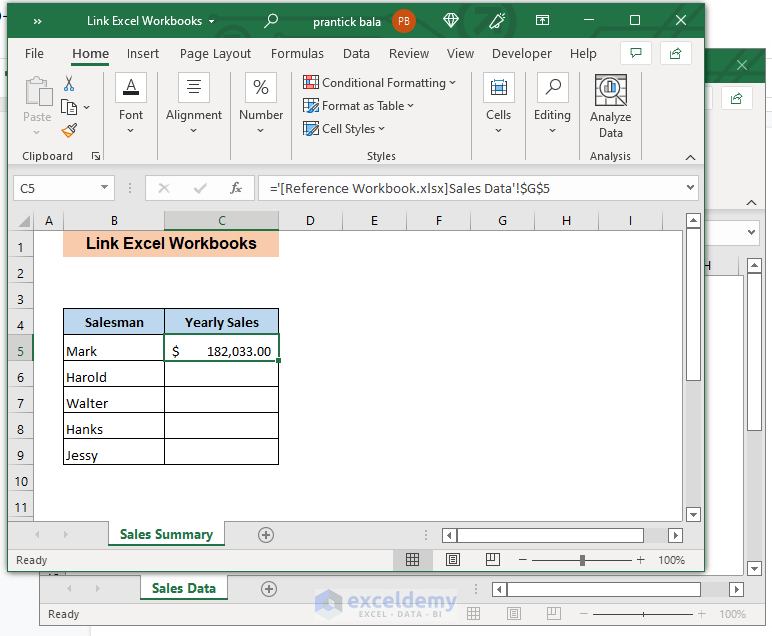Excel Mastery: Linking All Sheets Easily

Introduction to Excel Sheet Linking
Mastering Excel is not just about understanding formulas or creating visually appealing charts; it's also about harnessing the power of Excel to manage and organize data efficiently. One of the key features that can significantly boost your productivity in Excel is the ability to link sheets within the same workbook or even across different workbooks. Linking sheets allows for dynamic updates, reducing the need for repetitive data entry and minimizing errors. In this extensive guide, we'll delve into various methods for linking all sheets easily, exploring both simple and advanced techniques to streamline your workflow.
Understanding Cell References

Before we jump into linking sheets, let's briefly discuss cell references:
- Absolute Reference: This type of reference keeps the exact address of the cell, so changes in the position of the source or target cells do not affect the link. It's formatted as
=$A$1. - Relative Reference: Changes with the position of the linked cell. It’s typically formatted as
=A1. - Mixed Reference: Combines aspects of both absolute and relative references, like
=A$1or=$A1.
Linking Sheets Within the Same Workbook

Linking sheets in the same Excel workbook is straightforward. Here’s how:
Linking Cells Manually

- Select the cell where you want to place the linked data.
- Enter
=and navigate to the source sheet. You can click on the cell you want to link, or type in the sheet name and cell reference manually. For example,=Sheet2!A1. - Press Enter to confirm.
💡 Note: Ensure the sheet name does not contain spaces or special characters, or encapsulate the name in single quotes if necessary, like ='Sheet Name'!A1.
Using the Consolidate Function

When dealing with large datasets across multiple sheets, using the Consolidate feature can be quite handy:
- Select the range where you want the consolidated data to appear.
- Go to Data > Consolidate.
- Choose the function for consolidation (Sum, Count, Average, etc.).
- Select your ranges from the different sheets using the dropdown next to each range entry.
- Link to the source data for updates by checking Create links to source data.
🔔 Note: This method doesn't automatically update when new data is added to source sheets; consider using a VBA macro or a dynamic named range for real-time updates.
Linking Across Different Workbooks

Linking across different workbooks requires careful planning to ensure data integrity:
Manual Linking

- Open both workbooks.
- In the destination workbook, type
=and then switch to the source workbook. Select the cell or range you wish to link. - Complete the formula and press Enter. Excel will link the cell with the absolute reference of the source workbook.
Using Excel’s Data Connection

- Navigate to Data > Get Data > From File > From Workbook.
- Select the source workbook and specify the range.
- Your data will now appear in a query editor where you can transform data or directly load it into your workbook.
⚠️ Note: Ensure that all linked workbooks are stored in accessible locations and that links are not broken by moving or renaming files.
Dynamic Linking with Named Ranges

To make your links dynamic and easily updatable, consider using named ranges:
- Create a named range on the source sheet by selecting the range and typing a name in the Name Box or by using Formulas > Define Name.
- When linking, use the named range in your formulas like
=Sheet1!DataRange.
Linking Sheets with VBA Macros

For those comfortable with VBA, automating the process of linking sheets can save time and ensure consistency:
Creating VBA Code for Linking

Sub LinkSheets() Dim ws As Worksheet Dim targetWS As WorksheetSet targetWS = ThisWorkbook.Worksheets("Consolidated Data") For Each ws In ThisWorkbook.Worksheets If ws.Name <> targetWS.Name Then targetWS.Cells(ws.Index, 1).Value = ws.Name targetWS.Cells(ws.Index, 2).Formula = "=" & ws.Name & "!A1" End If Next ws
End Sub
📝 Note: This macro links the cell A1 from each sheet to the consolidated sheet. Adjust the code for specific ranges or sheets.
Real-World Applications of Sheet Linking

Here are some practical scenarios where linking sheets proves beneficial:
- Financial Reporting: Link data from different branches or departments into a master report for overview.
- Data Analysis: Dynamic linking for real-time data analysis across multiple datasets.
- Project Management: Tracking tasks, deadlines, and resources across multiple project sheets.
Best Practices for Linking Sheets

To ensure your linked Excel sheets work seamlessly:
- Use Meaningful Sheet Names: Names should be descriptive to make linking intuitive.
- Avoid Circular References: Ensure your links do not create a cycle that could break Excel's calculation.
- Consistent Data Structure: Maintain a uniform data layout across sheets for easy linking.
- Document Your Links: Keep a record or use comments to explain complex linking setups.
Conclusion

Linking sheets in Excel is an indispensable skill for anyone looking to improve their data management capabilities. From simple manual links to sophisticated VBA solutions, the methods discussed provide a robust foundation for automating your workflows. By integrating these techniques, you can significantly reduce manual errors, save time, and enhance the reliability of your data across various sheets or workbooks. Remember, while Excel offers powerful linking features, care must be taken in how data is organized, structured, and referenced to ensure the integrity of your analyses and reports.
What are the advantages of linking Excel sheets?

+
Linking Excel sheets reduces redundancy, ensures consistency across multiple datasets, automates updates, and saves time by reducing manual data entry.
Can I link sheets across different computers?

+
Yes, by using shared network drives or cloud storage solutions like OneDrive, you can link sheets across different computers, provided that all users have access to the same file locations.
What happens if I rename or move a linked workbook?

+
If you rename or move a linked workbook without updating the links, Excel will prompt for the new location or attempt to resolve the broken link itself. Ensure all links are updated to prevent errors.



